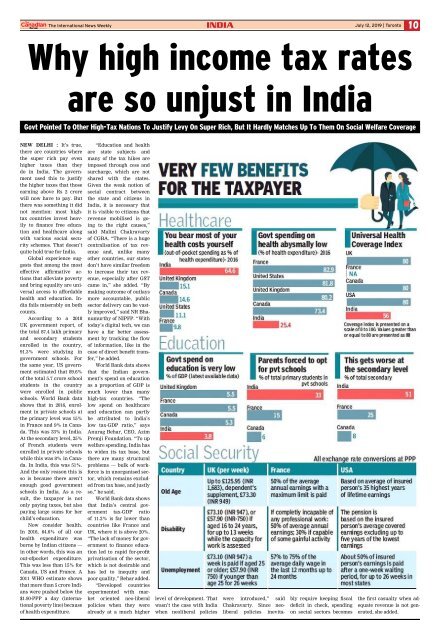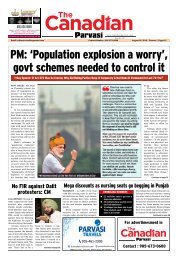You also want an ePaper? Increase the reach of your titles
YUMPU automatically turns print PDFs into web optimized ePapers that Google loves.
<strong>The</strong> International News Weekly INDIA<br />
July 12, 2019 | Toronto 10<br />
Why high income tax rates<br />
are so unjust in India<br />
Govt Pointed To Other High-Tax Nations To Justify Levy On Super Rich, But It Hardly Matches Up To <strong>The</strong>m On Social Welfare Coverage<br />
New Delhi : It’s true,<br />
there are countries where<br />
the super rich pay even<br />
higher taxes than they<br />
do in India. <strong>The</strong> government<br />
used this to justify<br />
the higher taxes that those<br />
earning above Rs 2 crore<br />
will now have to pay. But<br />
there was something it did<br />
not mention: most hightax<br />
countries invest heavily<br />
to finance free education<br />
and healthcare along<br />
with various social security<br />
schemes. That doesn’t<br />
quite hold true for India.<br />
Global experience suggests<br />
that among the most<br />
effective affirmative actions<br />
that alleviate poverty<br />
and bring equality are universal<br />
access to affordable<br />
health and education. India<br />
fails miserably on both<br />
counts.<br />
According to a 2018<br />
UK government report, of<br />
the total 87.4 lakh primary<br />
and secondary students<br />
enrolled in the country,<br />
91.3% were studying in<br />
government schools. For<br />
the same year, US government<br />
estimated that 89.6%<br />
of the total 5.7 crore school<br />
students in the country<br />
were enrolled in public<br />
schools. World Bank data<br />
shows that in 2016, enrolment<br />
in private schools at<br />
the primary level was 15%<br />
in France and 9% in Canada.<br />
This was 33% in India.<br />
At the secondary level, 25%<br />
of French students were<br />
enrolled in private schools<br />
while this was 8% in Canada.<br />
In India, this was 51%.<br />
And the only reason this is<br />
so is because there aren’t<br />
enough good government<br />
schools in India. As a result,<br />
the taxpayer is not<br />
only paying taxes, but also<br />
paying large sums for her<br />
child’s education.<br />
Now consider health.<br />
In 2016, 64.6% of all our<br />
health expenditure was<br />
borne by Indian citizens —<br />
in other words, this was an<br />
out-ofpocket expenditure.<br />
This was less than 15% for<br />
Canada, US and France. A<br />
2011 WHO estimate shows<br />
that more than 5 crore Indians<br />
were pushed below the<br />
$1.90-PPP a day (international<br />
poverty line) because<br />
of health expenditure.<br />
“Education and health<br />
are state subjects and<br />
many of the tax hikes are<br />
imposed through cess and<br />
surcharge, which are not<br />
shared with the states.<br />
Given the weak notion of<br />
social contract between<br />
the state and citizens in<br />
India, it is necessary that<br />
it is visible to citizens that<br />
revenue mobilised is going<br />
to the right causes,”<br />
said Malini Chakravarty<br />
of CGBA. “<strong>The</strong>re is a huge<br />
centralisation of tax revenue<br />
and, unlike many<br />
other countries, our states<br />
don’t have similar freedom<br />
to increase their tax revenue,<br />
especially after GST<br />
came in,” she added. “By<br />
making outcome of outlays<br />
more accountable, public<br />
sector delivery can be vastly<br />
improved,” said NR Bhanumurthy<br />
of NIPFP. “With<br />
today’s digital tech, we can<br />
have a far better assessment<br />
by tracking the flow<br />
of information, like in the<br />
case of direct benefit transfer,”<br />
he added.<br />
World Bank data shows<br />
that the Indian government’s<br />
spend on education<br />
as a proportion of GDP is<br />
much lower than many<br />
high-tax countries. “<strong>The</strong><br />
low spend on healthcare<br />
and education can partly<br />
be attributed to India’s<br />
low tax-GDP ratio,” says<br />
Anurag Behar, CEO, Azim<br />
Premji Foundation. “To up<br />
welfare spending, India has<br />
to widen its tax base, but<br />
there are many structural<br />
problems — bulk of workforce<br />
is in unorganised sector,<br />
which remains excluded<br />
from tax base, and justly<br />
so,” he said.<br />
World Bank data shows<br />
that India’s central government<br />
tax-GDP ratio<br />
of 11.2% is far lower than<br />
countries like France and<br />
UK, where it is above 20%.<br />
“<strong>The</strong> lack of money for government<br />
to finance education<br />
led to rapid for-profit<br />
privatisation of the sector,<br />
which is not desirable and<br />
has led to inequity and<br />
poor quality,” Behar added.<br />
“Developed countries<br />
experimented with market<br />
oriented neo-liberal<br />
policies when they were<br />
already at a much higher<br />
level of development. That<br />
wasn’t the case with India<br />
when neoliberal policies<br />
were introduced,” said<br />
Chakravarty. Since neoliberal<br />
policies inevitably<br />
require keeping fiscal<br />
deficit in check, spending<br />
on social sectors becomes<br />
the first casualty when adequate<br />
revenue is not generated,<br />
she added.
















